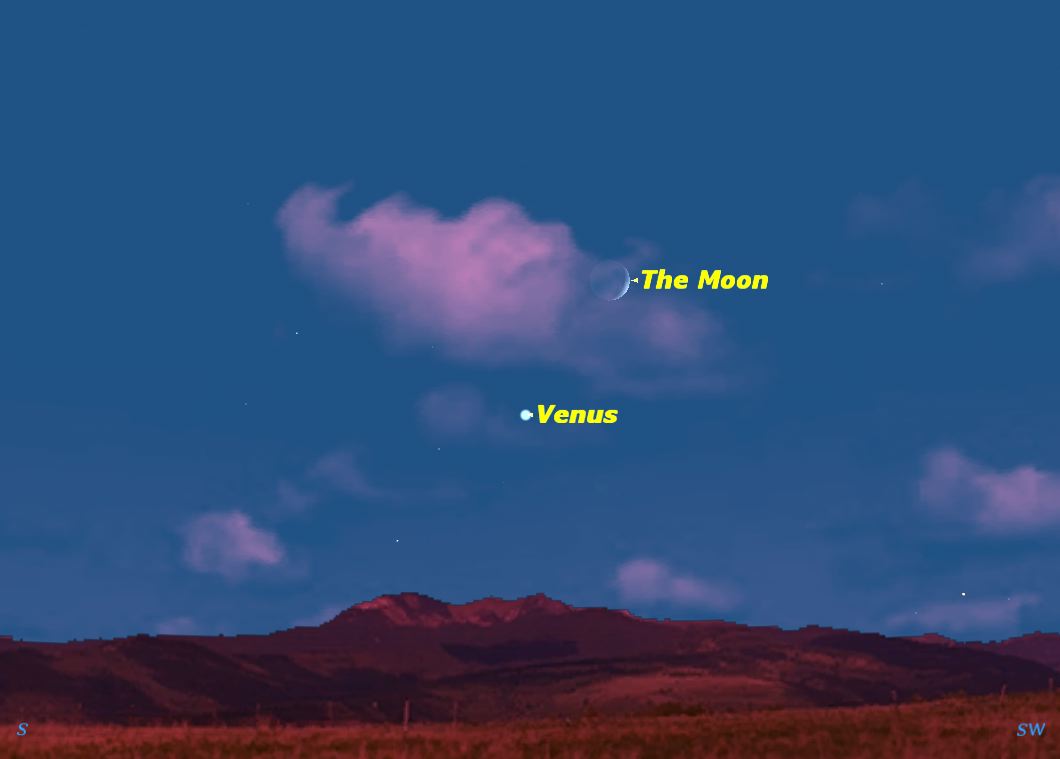See Venus Shine Near Crescent Moon Tonight

The moon will pass just north of the planet Venus tonight (Nov. 6), making a pretty pairing in the southwestern sky, weather permitting.
Venus is just past its greatest elongation from the sun, so in a telescope it resembles the Earth's moon just shy of the first quarter phase. Venus' disk is currently about 46-percent illuminated by the sun. The moon, which will appear just above Venus, is only 15-percent illuminated. It will be three more days before it matches Venus' angle of illumination.
The reason for this difference is the great difference in distance of the two night sky objects relative to the Earth and the resulting angle from which the sun which illuminates them. The moon is nearby, 226,000 miles (363,000 kilometers) away, so is mostly illuminated from behind. Venus, meanwhile, is much farther away, 58 million miles (93 million km) and so is illuminated almost exactly from the side, half-lit from our point of view. [Weirdest Facts About Venus]
This pair is a particularly pretty November night sky sight in binoculars because it is currently directly in front of one of the richest parts of the Milky Way. Two of the brightest nebulas in the sky, the Trifid (Messier 20) and Lagoon (Messier 8), lie right between Venus and the moon tonight.
The moon makes a wonderful sight in telescopes or even ordinary binoculars at this narrow crescent phase, just shy of four days old. Its most striking feature is that you can see the whole moon, not just the part in sunlight. The rest of the moon is lit up by an almost full Earth, so many of its seas, mountains, and craters are readily visibly by earthlight.
If you look more closely at the illuminated crescent, you will see the almost circular Mare Crisium dominating its northern half. This lunar "sea" marks the remains of an asteroid strike 4 billion years ago, leaving a flat lava field 345 miles (555 km) across. In a telescope, look south of the Mare Crisium for the large crater Petavius, 110 miles (177 km) in diameter, with a prominent central peak and a pair of rilles joining this peak to the crater walls.
Over the next few nights, watch as the lunar terminator, the dividing line between sunlight and shadow, sweeps across the moon’s face, revealing more craters in the south and "seas" in the north.
Breaking space news, the latest updates on rocket launches, skywatching events and more!
Editor's note: If you have an amazing night sky photo of Venus and the moon that you would like to share for a possible story or image gallery, please contact managing editor Tariq Malik at spacephotos@space.com.
This article was provided to SPACE.com by Starry Night Education, the leader in space science curriculum solutions. Follow Starry Night on Twitter @StarryNightEdu. Follow us @Spacedotcom, Facebook and Google+. Original article on SPACE.com.

Geoff Gaherty was Space.com's Night Sky columnist and in partnership with Starry Night software and a dedicated amateur astronomer who sought to share the wonders of the night sky with the world. Based in Canada, Geoff studied mathematics and physics at McGill University and earned a Ph.D. in anthropology from the University of Toronto, all while pursuing a passion for the night sky and serving as an astronomy communicator. He credited a partial solar eclipse observed in 1946 (at age 5) and his 1957 sighting of the Comet Arend-Roland as a teenager for sparking his interest in amateur astronomy. In 2008, Geoff won the Chant Medal from the Royal Astronomical Society of Canada, an award given to a Canadian amateur astronomer in recognition of their lifetime achievements. Sadly, Geoff passed away July 7, 2016 due to complications from a kidney transplant, but his legacy continues at Starry Night.

